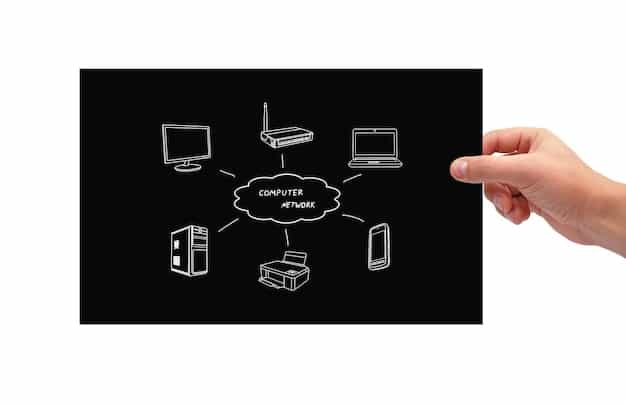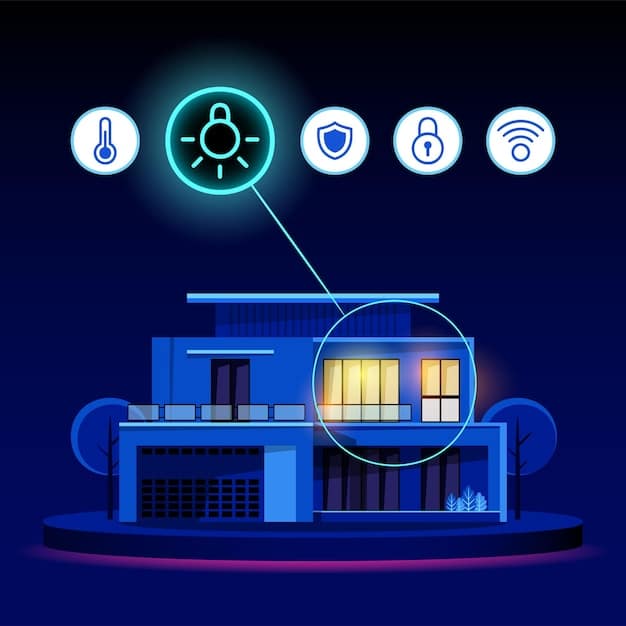Smart Home Security: Protecting Your Devices from IoT Hacking

Smart home security faces increasing threats as IoT hacking techniques evolve, exposing vulnerabilities in everyday devices and demanding proactive measures for protection.
In today’s connected world, smart home security: Are Your Devices Vulnerable to the Latest IoT Hacking Techniques? is a growing concern. With more devices integrated into our homes, understanding the risks and taking preventative measures is crucial for protecting your privacy and security.
Understanding the Landscape of Smart Home Security
The rise of smart home technology has brought convenience and efficiency but also introduced new security challenges. Understanding the interconnected nature of IoT devices and their potential vulnerabilities is the first step in creating a secure smart home environment.
The increasing number of devices connected to the internet within our homes has created a larger attack surface for hackers. Smart home security is no longer just about physical security; it’s about protecting your digital life.
The Explosion of IoT Devices
From smart thermostats to security cameras and even kitchen appliances, the number of IoT devices in homes continues to grow exponentially. This rapid expansion has outpaced the development of robust security protocols, leaving many devices vulnerable.
Why Smart Homes Are Attractive Targets
Smart homes are attractive targets because they offer hackers multiple points of entry. Once inside the network, hackers can access sensitive information, control devices, and potentially launch attacks on other networks.

- Weak passwords: Many users fail to change default passwords, leaving devices easily accessible.
- Outdated firmware: Manufacturers often neglect to update firmware, leaving known vulnerabilities unpatched.
- Lack of encryption: Some devices transmit data without encryption, allowing hackers to intercept sensitive information.
Understanding these vulnerabilities and taking proactive steps to address them is essential for maintaining a secure smart home.
Common IoT Hacking Techniques
Hackers are constantly developing new and sophisticated techniques to exploit vulnerabilities in IoT devices. Being aware of these common hacking methods is critical for protecting your smart home from cyberattacks.
Smart home security requires vigilance and a proactive approach to understanding and mitigating these threats. Hackers are always evolving their techniques, so staying informed is essential.
Brute-Force Attacks
Brute-force attacks involve trying numerous password combinations until the correct one is found. This technique is often successful against devices with weak or default passwords.
Man-in-the-Middle Attacks
In a man-in-the-middle attack, hackers intercept communication between devices and the network, allowing them to steal sensitive information or manipulate data.
- Regularly update device firmware: Software updates often include security patches that address known vulnerabilities.
- Use strong, unique passwords: Avoid using default passwords and opt for complex, hard-to-guess passwords.
- Enable two-factor authentication: Add an extra layer of security by requiring a second verification method.
By understanding common IoT hacking techniques, you can implement more effective security measures to protect your smart home.
Securing Your Smart Home Network
Your home network is the central hub for all your smart devices, making it a primary target for hackers. Securing your network is essential for protecting all connected devices.
Implementing robust security measures at the network level is a fundamental aspect of smart home security. A secure network acts as the first line of defense against cyber threats.
Strengthening Your Router Security
Your router is the gateway to your home network, so it’s crucial to ensure it’s properly secured. Change the default password, enable encryption, and keep the firmware updated.
Creating a Guest Network
Setting up a separate guest network for visitors or less secure devices can help isolate your primary network and prevent unauthorized access to sensitive data.

- Enable WPA3 encryption: This latest encryption standard provides stronger security compared to older protocols like WPA2.
- Disable WPS: Wi-Fi Protected Setup (WPS) is a convenient feature but can be vulnerable to hacking.
- Monitor network activity: Regularly review your router’s logs to identify any suspicious activity.
Securing your smart home network requires a multifaceted approach, but the benefits of protecting your digital life are well worth the effort.
Specific Device Vulnerabilities and Solutions
Each type of smart home device has its own unique vulnerabilities. Understanding these specific weaknesses can help you implement targeted security measures.
Addressing device-specific vulnerabilities is a key component of comprehensive smart home security. A one-size-fits-all approach is not sufficient to protect against the diverse range of threats.
Smart Cameras and Surveillance Systems
Smart cameras can be vulnerable to hacking, allowing unauthorized access to live feeds and recorded footage. Secure your cameras with strong passwords and enable encryption.
Smart Locks and Door Access Systems
Smart locks offer convenience, but they can also be targeted by hackers looking to gain unauthorized access to your home. Use strong passwords and enable two-factor authentication.
- Smart Thermostats: Change the default password and regularly update the device’s firmware.
- Smart Speakers: Review privacy settings and disable features you don’t use.
- Smart TVs: Secure your smart TV by changing the default password and configuring privacy settings.
By addressing the specific vulnerabilities of each device in your smart home, you can significantly increase your overall security posture.
Best Practices for Password Management
Strong password management is a fundamental aspect of smart home security. Using weak or reused passwords can leave your devices and network vulnerable to attack.
Effective password management is a cornerstone of smart home security. It’s the first line of defense against many common hacking techniques.
Creating Strong, Unique Passwords
Use a combination of uppercase and lowercase letters, numbers, and symbols to create strong passwords that are difficult to guess. Avoid using personal information or common words.
Using a Password Manager
A password manager can help you generate and store strong, unique passwords for all your devices and accounts. This eliminates the need to remember multiple complex passwords.
- Change default passwords: Always change the default passwords on your smart home devices.
- Avoid reusing passwords: Use a different password for each device and account.
- Enable two-factor authentication: Add an extra layer of security whenever possible.
Implementing these password management best practices can significantly improve the security of your smart home.
Staying Updated on the Latest Threats
The landscape of IoT security is constantly evolving, with new threats emerging regularly. Staying informed about the latest vulnerabilities and security best practices is crucial for maintaining a secure smart home.
Continuous learning and adaptation are essential for effective smart home security. The threats are constantly evolving, so your defenses must evolve as well.
Following Security News and Blogs
Stay updated on the latest security threats by following reputable security news outlets and blogs. These resources often provide valuable information about new vulnerabilities and security best practices.
Regularly Reviewing Device Security Settings
Periodically review the security settings of your smart home devices to ensure they are configured for maximum security. Check for firmware updates and enable any available security features.
- Join online security communities: Engage with other security-conscious individuals to share information and learn from each other.
- Attend security webinars and conferences: These events can provide valuable insights into the latest security trends and best practices.
- Consult with security professionals: Consider hiring a security professional to assess your smart home security and provide personalized recommendations.
By staying informed and proactive, you can stay one step ahead of potential attackers and protect your smart home from the latest threats.
| Key Point | Brief Description |
|---|---|
| 🔑 Strong Passwords | Use unique, complex passwords for all devices and accounts. |
| 🔄 Regular Updates | Keep your devices and network firmware updated to patch vulnerabilities. |
| 📶 Secure Network | Secure your home network with strong encryption and a guest network. |
| 🛡️ Device-Specific Security | Address specific vulnerabilities of each device in your smart home. |
FAQ
▼
The biggest risks include weak passwords, outdated firmware, unencrypted data transmission, and vulnerabilities in specific device types like cameras and smart locks.
▼
Use a combination of uppercase and lowercase letters, numbers, and symbols. Avoid using personal information or common words, and aim for at least 12 characters.
▼
Firmware updates often include security patches that address known vulnerabilities. Keeping your devices updated helps protect against potential attacks and exploits by hackers.
▼
Two-factor authentication requires a second verification method in addition to your password, such as a code sent to your phone. It adds an extra layer of security to your accounts.
▼
Use a strong, unique password, enable encryption, disable remote access if not needed, and keep the camera’s firmware updated. Consider covering the lens when not in use.
Conclusion
Protecting your smart home is a continuous effort that requires vigilance and proactive measures. By understanding the risks, implementing robust security practices, and staying updated on the latest threats, you can create a secure and enjoyable smart home experience.





